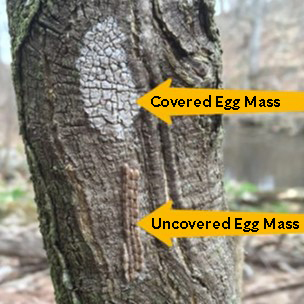For Faster Service Call Directly
FREE INSPECTION
Request Your Spotted Lanternfly Inspection:
Getting rid of spotted lanternflies is a significant challenge, as they've continued to spread through our region since they first infested Pennsylvania in 2014. The key to eliminating spotted lanternflies is to eliminate their eggs. However, we have found that regular treatment of areas around your home that are at risk is also effective. Our pest control experts are trained to inspect at-risk areas, including trees, shrubs, fences, and lawn furniture, for eggs and to provide appropriate treatment. Every home and yard is unique, so our pest professionals will customize their treatment to your home.
When you hire one of our pest professionals, you get a trained and certified specialist who will come to your home armed with all the supplies necessary to do the job right. He or she will talk with you about your property, provide a thorough inspection, share findings and recommendations, and begin treatments immediately.
If you are finding that your plants are beginning to ooze, weep, or have a fermented odor, they may be infested. Another sign of an infestation could be a buildup of sticky fluid (also known as honeydew) or soot-like mold that is on or around your plants. You can also inspect plants and trees for signs of spotted lanternflies or their eggs. If there is any evidence of an infestation, call American Pest.
Step 1: Locating and eliminating egg masses and areas of risk around the property
Step 2: Remove any egg masses discovered during inspection
Step 3: Treating the exterior areas that are appealing to spotted lanternflies
Whether your spotted lanternfly problems are large or small, our service pros are ready to diagnose and target treatments based on an infestation level and at-risk agriculture around your home.
Not sure if you're at risk? No problem! Let our top-rated pest control technicians inspect and share their experience and recommendations with you. Armed with your knowledge of your home, we can work together to develop a treatment solution that is safe, effective, and intelligent. Complete the form below or call 301-232-5845 and tell them you're concerned about spotted lanternflies.
Spotted lanternflies have caused crippling effects on agriculture because they feed on the plant juices of over 70 economically important species of agricultural and ornamental plants. Damages to these plants may include oozing stalks, reduced yields, lower fruit sugar content, vine dieback, and reduced flowering in subsequent growing seasons. Some of the common agricultural and ornamental plants that are at risk include:
Purple = Sighting Reported
Pink=Sighting Reported with quarantine
Orange = Infestation Present
Red = Infestation Present with quarantine
Since spotted lanternflies have been classified as an invasive species that is continuing to spread, quarantine is put in place to ensure that any material or object that could harbor the pest cannot be moved without taking precautions to prevent its spread. If you discover spotted lanternflies on or around your property, it is important to contact a pest professional like American Pest and to make sure that you are following appropriate steps to prevent the spread and to ensure you aren't amplifying the spread of this invasive species.
Maryland:
Virginia
Request Your Spotted Lanternfly Inspection:
Spotted Lanternflies prefer to lay their eggs on a host tree but may also lay them on other flat surfaces like buildings, fences, vehicles, etc. Spotted lanternfly eggs are usually in groups of 30-60 and are coated in gray wax. When dried, that wax can look similar to a splash of mud, making it extremely well camouflaged with its surroundings. If discovered, scrape the egg mass from the surface and place it into a plastic bag with hand sanitizer or alcohol.

After a female spotted lanternfly lays egg masses of 30-60 eggs, she will cover them with a creamy-white, putty-like substance that starts to crack after a few weeks, resembling a splotch of mud. Uncovered spotted lanternfly eggs are still easily missed, depending on where they're laid. You can see in the photo above that the uncovered spotted lanternfly eggs are easily camouflaged with the tree bark.
At American Pest, we have a program that fits any home & any pest need.
Find out what our customers are saying. Click links to read or leave a review.
Angi's List Customer
The service technician was punctual, courteous, and very thorough. He took the time to explain each step in the process to treat our home. And, the services have resulted in a reduction/near elimination of pests in and around our home.”
E. Smith - Rockville, MD
“ I wanted to write to say how impressed I am with your entire crew and the general way you operate. Everyone who entered my home was sympathetic, sensitive, competent, and respectful. I think what stands out was the way your company understood, and expressed in its own way, the psychological damage that bed bugs inflict.”
T. Campbell - Silver Spring, MD
“ We've been using this company for years. They provide consistent, high-quality service. Since we started using American Pest we have had far fewer pest problems, and the few that we've had have been addressed within days.
We align with the best, to bring you the best.




If you have questions about our services, plans, or pricing, we are here for you. Call or fill out the form to communicate by email.